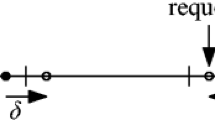Abstract.
We extend the definition of Metrical Task Systems, introduced by Borodin et al. in [4]. In the extended definition, a system is described by the underlying metric space of states \({\cal M}\) as well as a set of allowable tasks \({\cal T}\) . Any request to an algorithm must be a member of \({\cal T}\) . The extension makes the model powerful enough to characterize completely many important on-line problems. We consider methods of designing competitive algorithms given the description of a system \(\langle {\cal M}, {\cal T} \rangle\) . In particular, we show that it is PSPACE-hard to determine the behavior of a \(c({\cal M},{\cal T})\) -competitive algorithm, where \(c({\cal M},{\cal T})\) is the best possible competitive ratio on \(\langle {\cal M},{\cal T} \rangle\) . In addition, we show a simple, polynomial-time algorithm for task systems \(\langle {\cal U}_n,{\cal T} \rangle\) (where \({\cal U}_n\) is the uniform metric space on n nodes) that achieves a competitive ratio of \(O( \log n \cdot c({\cal M},{\cal T}))\) .
Similar content being viewed by others
Author information
Authors and Affiliations
Additional information
Received January 30, 1995; revised February 13, 1996.
Rights and permissions
About this article
Cite this article
Burley, W., Irani, S. On Algorithm Design for Metrical Task Systems. Algorithmica 18, 461–485 (1997). https://doi.org/10.1007/PL00009166
Issue Date:
DOI: https://doi.org/10.1007/PL00009166




